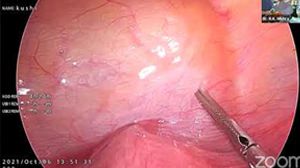Do’s & Don’t’s after Laparoscopic Surgery
Add to
Share
2,081 views
Report
2 years ago
Description
Do's and Don'ts After Laparoscopic Surgery: A Guide to Optimal Recovery Introduction: Laparoscopic surgery, also known as minimally invasive surgery, has revolutionized the field of medicine by offering patients a faster recovery time, reduced pain, and smaller incisions. However, it is crucial to follow specific guidelines to ensure a smooth and successful recovery. This essay aims to provide a comprehensive overview of the do's and don'ts after laparoscopic surgery, highlighting key aspects that patients should keep in mind to optimize their healing process. The Do's: Rest and Relaxation: Following surgery, prioritize ample rest to allow your body to heal. Avoid engaging in strenuous activities and take time off work or daily responsibilities. Follow Post-operative Instructions: Adhere strictly to the instructions provided by your surgeon and medical team. These may include guidelines on wound care, medication, and dietary restrictions. Take Prescribed Medications: It is essential to take all prescribed medications as instructed by your healthcare provider. This includes pain medication, antibiotics, or any other medications prescribed to aid in your recovery. Keep Incision Sites Clean and Dry: Proper hygiene is crucial to prevent infection. Follow the guidelines provided by your surgeon regarding wound care, keeping the incision sites clean, and avoiding excessive moisture. Eat a Balanced and Nutritious Diet: Focus on consuming a diet rich in fruits, vegetables, lean proteins, and whole grains. Adequate nutrition supports the healing process and boosts your immune system. Stay Hydrated: Drink plenty of water to maintain hydration, which aids in the recovery process and helps prevent complications such as constipation. Gradually Increase Physical Activity: While rest is crucial, engaging in light physical activities, as recommended by your healthcare provider, can promote circulation, prevent blood clots, and aid in healing. Start with gentle exercises, such as short walks, and gradually increase your activity level. Attend Follow-up Appointments: Regularly scheduled follow-up appointments allow your surgeon to monitor your progress, address any concerns, and make adjustments to your recovery plan if needed. Communicate Any Concerns or Complications: If you experience unusual symptoms, complications, or have any concerns during your recovery, promptly communicate with your healthcare provider. Early intervention can prevent potential complications. The Don'ts: Lift Heavy Objects: Avoid lifting heavy objects or engaging in strenuous activities during your recovery period. Straining or overexertion can strain your incisions and lead to complications. Engage in Strenuous Activities or Exercises: Give your body ample time to heal before resuming intense physical activities or exercises. Consult your surgeon for specific guidelines on when it is safe to resume your regular exercise routine. Drive until Cleared by the Surgeon: Do not drive until your surgeon gives you the green light. Anesthesia, pain medications, and the stress of driving can impair your reaction times and decision-making abilities. Ignore Signs of Infection or Complications: Pay close attention to your incision sites for any signs of infection, such as redness, swelling, or discharge. Additionally, watch for other potential complications, such as excessive bleeding or persistent pain, and promptly inform your healthcare provider. Skip Medications or Prescribed Treatments: It is crucial to follow the medication schedule prescribed by your surgeon. Skipping doses or discontinuing medications without medical advice can hinder the healing process. Smoke or Consume Alcohol Excessively: Smoking delays the healing process and increases the risk of complications. Similarly, excessive alcohol consumption can interfere with wound healing and interact negatively with medications. Wear Tight Clothing or Belts around the Incision Sites: Avoid wearing tight clothing or belts that may rub against or put pressure on the incision sites. Opt for loose-fitting and comfortable clothing during your recovery period. Neglect Proper Wound Care: Follow your surgeon's instructions for wound care meticulously. Keep the incision sites clean and dry, and avoid exposing them to irritants or excessive moisture. Delay Seeking Medical Help for Severe Pain or Unusual Symptoms: If you experience severe pain, excessive bleeding, fever, or any unusual symptoms that cause concern, seek immediate medical attention. Do not delay in reporting such symptoms to your healthcare provider. Conclusion: Adhering to the do's and don'ts after laparoscopic surgery is vital for a successful recovery. By following these guidelines, patients can promote optimal healing, reduce the risk of complications, and ensure a smooth transition back to their regular activities. Remember, every individual's recovery may vary, so it is essential to consult your healthcare provider for personalized advice and instructions tailored to your specific case. With proper care and attention, you can enhance your recovery experience and regain your health swiftly and safely.
Similar Videos






